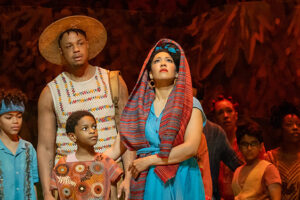

Therefore, an unstaged performance of Juditha by five soloists and the Venice Baroque Orchestra under Andrea Marcon was a likely (and comparatively inexpensive) event in the current Serenissima Festival of Venetian arts being celebrated around town. It seems to me a pity that the three operatic contributions of the Festival—Juditha, Handel’s Agrippina at Juilliard and Monterverdi’s Poppea—are all familiar to New Yorkers; this would seem an opportune occasion to introduce something we don’t know, as is being done in the stage-play line.
Juditha has been given in New York by one company or another several times since its 1952 premiere here, each occasion after a comprehensive revision of ideas of baroque operatic performance. Therefore, in a sense, we meet it anew each time it is performed. I can’t recall much of my encounter with it around 1978 at Philharmonic Hall (sic), given by another visiting Italian company, but I remember finding it a surprisingly excellent piece—surprising because Vivaldi’s work as a theater composer has been overshadowed by the work of Handel and others. The Carnegie Hall performance on Tuesday night assured me my earlier response had been correct.
The line between opera and oratorio was, in the Most Serene Republic of Venice, even hazier than it was at that same era in Handel’s London or Telemann’s Hamburg or Bach’s Leipzig, the musical distinction between secular and sacred dramas barely perceptible. Basically, we have the once popular (oft painted) Apocryphal tale of the Hebrew widow who seduces and then beheads an Assyrian general, cleaned up for GP churchgoing audiences (in this version, Holofernes falls into deep sleep from too large a meal) and fleshed out with commentaries and sermonettes by subsidiary characters.
The only “action” is the decapitation, deep into Act II, and that is not dwelt upon. The tension arises from wondering how long Judith can keep the general’s lusts at bay and whether she and her servant, Abra, will get away with it. If you know your Apocrypha, you can be sure they do.
How did Vivaldi, man of the theater though a priest, enliven the Lenten spectacle of a tale with so little action? He must have had five extraordinary voices, to be sure, all given to women (the higher sopranos for the aristocrats, lower voices for soldiers on duty), plus a small chorus, probably also female given that Vivaldi conducted the famous orchestra of a girls’ orphanage. At Carnegie, the chorus was provided by the small but adept all-female ensemble TENET, even when portraying rowdy soldiery.
But most striking on this occasion (and, no doubt, in 1716) was the variety, not merely of types of aria or the dance rhythms to which the individual arias were set, but the dazzling array of instrumental accompaniments chosen. There were theorbos and violas d’amore, recorders of every shape and size and a bravura chalumeau, a sort of pre-clarinet, to imitate the cooing of turtledoves. An aria of welcome included interspersed choral lines in a sophisticated manner that anticipated operatic transformations usually credited to the likes of Gluck and Mozart. Maestro Marcon led his skilled and well-adjusted forces with close and superb detail.
Judith, was sung by the dulcet-voiced mezzo Delphine Galou, who with many ironic looks tossed our way, gave the lie while she warbled double-entendres in Holofernes’ direction. She sang an especially tender (and effective) lullaby to the overstuffed general, and forthright Mary-Ellen Nesi’s martial manner promptly underwent a change to somnolence.
His a.d.c., Vagaus, sung by the elaborately ornamental Ann Hallenberg, on discovering carnage when expecting a scene of post-orgy excess, expressed horror in a manner familiar to any lover of the baroque scena di pazzia. As Judith’s servant, Abra, Silke Gäng had some ringing phrases of triumph at the happy sight of the missing head. Salome this isn’t.
This is a various and surprising score, arousing curiosity about the other surviving Vivaldi operas. Are they as intriguing? In which case, why is Juditha the one we always hear? And if they re not as interesting, why not? I believe only one major American company—San Francisco, in the heyday of Marilyn Horne—has ever staged a Vivaldi opera.
One thing that rather affected one’s pleasure in this concert was that the singers, all of great ability and a certain fame, were barely audible during Act I, their subtler and more intricate coloratura obscured by the small and far from grand orchestra. From my seat on the Parquet level, I had to strain to make out what they were doing. After the intermission, though, when the martial Ozias, the Hebrew commander (sturdy, dark-toned Francesca Ascioti) made a first appearance, I sat back contented: a voice at last!
But then all the voices, so overshadowed in Act I, were clear and brilliant in Act II, the trills and roulades actually audible over the orchestral accompaniment. There were no microphones (and each voice came from the singer’s mouth), so one must assume that someone informed the company during the intermission that they were not making the proper effect.
Is this a matter of preparing the work in small Venetian churches, not realizing that Stern Auditorium is the size of any four of them put together? The alteration certainly enhanced the delight given by the music.























Comments